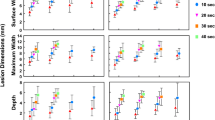Abstract
Introduction: Cooled radiofrequency ablation has been developed clinically for the treatment of ventricular tachycardia. Although clinical studies employ a constant saline flow rate for cooling, we hypothesized that varying the flow rates might optimize the temperature profile at depth.
Methods: In excised ovine left ventricle, we compared the temperature profile from a catheter tip electrode thermocouple to those placed at depths of 0.0mm, 1.0mm, and 2.0mm. We compared the following settings: 20Watts without flow, 20Watts with 0.3cc/sec flow, 20Watts with 0.5cc/sec flow, and 70°C surface temperature without flow (temperature control).
Results: The temperatures decreased from 77.5±10.5°C, 91.7±6.3°C, 65.5±11.8°C, and 52.5±11.8°C at 20W without saline irrigation at the tip, 0.0mm, 1.0mm, and 2.0mm, respectively, to 33.0±1.4°C*, 63.4±7.0°C*, 57.1±5.8°C*, 49.9±5.8°C+ at 20W with 0.5ml/sec flow (*P<0.01, +P=0.09). The lesion volumes were 79.6mm3 for 20W without flow, 64.1mm3 for 20W with 0.3ml/sec flow, 47.5mm3 for 20W with 0.5ml/sec flow, and 28.6mm3 for temperature control.
Conclusions: We conclude that 1) the temperature profile greatly depends upon the rate of saline flow for cooling; 2) at high flow rates, the 0.0mm and 1.0mm temperatures are similar; 3) even at high irrigation rates, lesion size is greater than for temperature control; 4) the tip temperature significantly underestimates the surface temperature and improved methods of measuring temperature are needed.
Similar content being viewed by others
References
Jackman WM, Wang X, Friday KJ, et al. Catheter ablation of accessory pathways (Wolf-Parkinson-White Syndrome) by radiofrequency current. N Engl J Med 1991;324:1605–1611.
Kuck HK, Schlutter M, Geiger M, et al. Radiofrequency current catheter ablation of accessory pathways. Lancet 1991;337:1557–1561.
Calkins H, Sousa J, El-Atassi R, et al. Diagnosis and cure of Wolf-Parkinson-White syndrome or paroxysmal supraventricular tachycardias during a single electrophysiological test. N Engl J Med 1991;324: 1612–1618.
Kay GN, Epstein AE, Dailey SD, et al. Selective radiofrequency ablation of the slow pathway for the treatment of atrioventricular nodal reentrant tachycardia: evidence for the involvement of perinodal myocardium within the reentrant circuit. Circulation 1992;85: 1675–1688.
Lesh MD, Van Hare GF, Schamp DJ, et al. Curative percutaneous catheter using radiofrequency ablation for accessory pathways in all locations: results in 100 consecutive patients. J Am Coll Cardiol 1992;19: 1303–1309.
Morady F, Harvey M, Kalbfleisch SJ, et al. Radiofrequency catheter ablation of ventricular tachycardia in patients with coronary artery disease. Circulation 1993;87:363–372.
Avitall B, Khan M, Krum D, et al. Physics and engineering of transcatheter cardiac tissue ablation. J Am Coll Cardiol 1993;22:932–943.
Wang PJ, Estes NAM III. Physics and biology of catheter ablation. In: Singer I ed. Nonpharmacological therapy of arrhythmias for the 21st century: the state of the art. Armonk, NY: Futura; 1993:3–26.
Mittleman RS, Huang SKS, De Guzman WT, et al. Use of the saline infusion electrode catheter for improved energy delivery and increased lesion size in radiofrequency catheter ablation. PACE 1995;18:1022–1027.
Skrumeda LL, Maguire MA, Mehra R. Effect of delivering saline at a low flow rate on RF lesion size in the left ventricle (Abstract). PACE 1995;18:921.
Nakagawa H, Yamanashi W, Wittkampf F, et al. Comparison of tissue temperature and lesion size in radiofrequency ablation using saline irrigation with a small versus large tip electrode in a canine thigh muscle preparation (Abstract). PACE 1995;18:917.
Ruffy R, Santel D, Whittaker P, et al. Radiofrequency delivery through an endocardial cooled catheter results in increased lesion size (Abstract). Circulation 1993;88(suppl 1):I–164.
Sykes C, Riley R, Pomeranz M, et al. Cooled tip ablation results in increased radiofrequency power delivery and lesion size (Abstract). PACE 1994;17:782.
Nakagawa H, Yamanashi WS, Pitha JV, et al: Comparison of in vivo tissue temperature proflle and lesion geometry for radiofrequency ablation with a saline-irrigated electrode versus temperature control in a canine thigh muscle preparation. Circulation 1995;91:2264–2273.
Ruffy R, Imran MA, Santel DJ, et al. Radiofrequency delivery through a cooled catheter tip allows the creation of larger endomyocardial lesions in the ovine heart. J Cardiovasc Electrophysiol 1995;6:1089–1096.
Wharton JM, Nibley C, Sykes CM, et al. Establishment of a dose-response relationship for high power chilled-tip radiofrequency current ablation in sheep (Abstract). J Am Coll Cardiol 1995;Feb:293A.
Nibley C, Sykes DM, Chapman T, et al. Prevention of impedance rise during radiofrequency current catheter ablation by intra-electrode tip chilling (Abstract). Circulation 1994;90:I–271.
Nibley C, Sykes CM, Rowan R, et al. Predictors of abrupt impedance rise during chilled-tip radiofrequency catheter ablation (Abstract). J Am Coll Cardiol 1995;Feb:293A.
Nakagawa H, Khastgir T, Arruda M, et al. Radiofrequency catheter ablation using a saline irrigated electrode in patients with prior failed accessory pathway ablation (Abstract). PACE 1995;18:832.
Arruda M, Nakagawa H, Khastgir T, et al. Facilitation of accessory pathway ablation from the middle cardiac vein by a saline irrigated catheter electrode (Abstract). PACE 1995;18:832.
Nakagawa H, Yamanashi WS, Pitha JV, et al. Effective delivery of radiofrequency energy through the coronary sinus without impedance rise using a saline irrigated electrode (Abstract). J Am Coll Cardiol 1995;777A.
Calkins H, Wharton JM, Epstein AE, et al. Safety and efficacy of catheter ablation of ventricular tachycardia using the cooled ablation system: final report (Abstract). PACE 1998;21:842.
Matsudaria K, Nakagawa H, Yamanashi WS, et al. Differential effects of saline irrigation flow rates on lesion depth and lesion volume (Abstract). PACE 1999;22:800.
Author information
Authors and Affiliations
Rights and permissions
About this article
Cite this article
Wong, W.S., VanderBrink BS*, B.A., Riley MS, R.E. et al. Effect of Saline Irrigation Flow Rate on Temperature Profile during Cooled Radiofrequency Ablation. J Interv Card Electrophysiol 4, 321–326 (2000). https://doi.org/10.1023/A:1009802721012
Issue Date:
DOI: https://doi.org/10.1023/A:1009802721012




